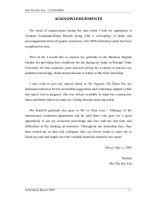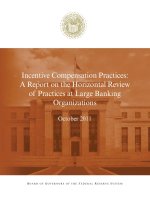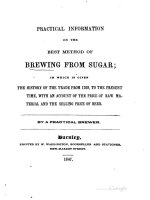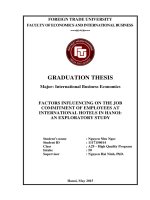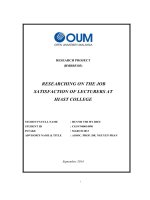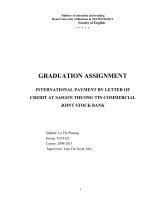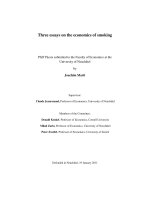Graduation thesis on international payment method of letter of credit at sacombank
Bạn đang xem bản rút gọn của tài liệu. Xem và tải ngay bản đầy đủ của tài liệu tại đây (1.28 MB, 88 trang )
UNIVERSITY OF ECONOMICS HO CHI MINH CITY
INTERNATIONAL BUSINESS SCHOOL
GRADUATION THESIS:
“HOW TO IMPROVE THE EFFICIENCY OF LC PAYMENT METHOD AT
SACOMBANK- TAN BINH BRANCH”
GUIDED BY: PRO. DOAN THI HONG VAN
i
GRATITUDE
After four years of studying precious knowledge at the University of
Economics Ho Chi Minh city, trained, instructed, taught by respectful
lecturers, I have learned and accumulated so much knowledge and
experience for my self that are very important for my future career path.
Within the internship period, I have got acquainted with new environment,
learned a great deal of realistic knowledge and experience as well as how to
go from academics to reality.
Sacombank- Tan Binh branch was the first practical environment I have
ever been. During the time, I was being instructed heartedly by ProfessorDoctor. Doan Thi Hong Van- lecturer of the faculty of Commerce, Tourism
and Marketing, associated with enthusiastic supports from officers working
at international payment division of Tan Binh branch.
This thesis is built from the basis of association between theory and actual
result of my internship period at the branch. Through this, I would like to
express honest thanks to the board of lecturer, respectful lecturers of the
University, lecturers of the faculty, that have dedicatedly directed over the
time, especially Professor –Doctor. Doan Thi Hong Van who directly
instructed to complete this thesis. The professor devotedly directed and
created every chance for me to finish the thesis successfully.
I would also like to bring my thanks to all those officers working at
international payment division of Tan Binh branch.
Finally, I would like to give all of you a great wish for health, happiness, and
success in your career paths and your lives.
HCMC, 30th, March, 2012
ii
Tran Thanh Tuyen
SACOMBANK-TAN BINH RBANCH COMMENT
.......................................................................................................................................
.......................................................................................................................................
.......................................................................................................................................
.......................................................................................................................................
.......................................................................................................................................
.......................................................................................................................................
.......................................................................................................................................
.......................................................................................................................................
.......................................................................................................................................
.......................................................................................................................................
.......................................................................................................................................
.......................................................................................................................................
.......................................................................................................................................
.......................................................................................................................................
.......................................................................................................................................
.......................................................................................................................................
.......................................................................................................................................
.......................................................................................................................................
.......................................................................................................................................
.......................................................................................................................................
HCMC,…… date
iii
, month
, 2012
INSTRUCTOR’S COMMENT
.......................................................................................................................................
.......................................................................................................................................
.......................................................................................................................................
.......................................................................................................................................
.......................................................................................................................................
.......................................................................................................................................
.......................................................................................................................................
.......................................................................................................................................
.......................................................................................................................................
.......................................................................................................................................
.......................................................................................................................................
.......................................................................................................................................
.......................................................................................................................................
.......................................................................................................................................
.......................................................................................................................................
.......................................................................................................................................
.......................................................................................................................................
.......................................................................................................................................
.......................................................................................................................................
.......................................................................................................................................
........................................................................................................................................
HCMC,…… date
iv
, month
, 2012
SUMMARY
*********@*********
In the tendency of deep globalisation of the world economy nowadays,
international trade has been playing a vital role in the global economic
system. In order to enhance the efficiency of transactions among nations
worldwide, one of the most important issues must be improved first is
international payment methods among which documentary credit payment is
a very important and common used one all over the world. With
understanding of its role, after contacting and learning realistic knowledge
and experience at Sacombank-Tan Binh branch during the internship period
there, I chose the matter of “Solutions to enhance documentary credits
payment activities at Sacombank-Tan Binh branch” to be my thesis topic.
This thesis will introduce you to the deeply basic theory for the payment
method and the actual information about Sacombank in general and Tan
Binh branch in particular as well as the situation of the payment method
activities at the branch, and finally some empirical solutions will be
introduced to help the bank improve the the payment activities. Specifically,
Chapter 1 talks about theory from the definition of the payment method to
common factors affecting the payment activities. Next, Chapter 2 firstly
introduces information about Sacombank and Tan Binh branch, and then
chapter 3 talks about the actual situation of the payment activities at the
branch. Lastly, Chapter 4 is to present some practical solutions that are
resulted from related information and database collected from the bank to
enhance the method activities.
I hope that this thesis will reflect how hard I have worked on my study at the
University as well as my internship at Tan Binh branch, simultaneously
could contribute somewhat to the method improvement at Sacombank in
general and at Tan Binh branch in particular.
v
TABLE OF CONTENT
INTRODUCTION ................................................................................................................. 1
1. Problem Statement ......................................................................................................... 1
2. Research objectives ....................................................................................................... 2
3. Modus Operandi ............................................................................................................. 2
4. Methodology .................................................................................................................... 2
5. Structure of content ........................................................................................................ 2
CHAPTER 1: ........................................................................................................................ 4
1.1
Overview of Documentary Credits Payment Method ........................................ 4
1.1.1
Definition ........................................................................................................... 4
1.1.2
Regulatory Basis ............................................................................................. 4
1.1.2.1 UCP 600 ....................................................................................................... 4
1.1.2.2 ISBP 681....................................................................................................... 5
1.1.3
Concerned Parties .......................................................................................... 5
1.1.4
Functional Procedure ..................................................................................... 6
1.1.5
Fundermental principles of Documentary Credits...................................... 9
1.2
Letter of Credit ....................................................................................................... 10
1.2.1
Definition ......................................................................................................... 10
1.2.2
Main content................................................................................................... 10
1.2.3
Types of Letter of Credit............................................................................... 11
1.2.3.1 Basic Types of Letter of Credit ................................................................ 11
1.2.3.2 Special Types of Letter of Credit ............................................................ 12
1.3
Pros and Cons of Documentary Credits ............................................................ 13
1.3.1
Pros of Documentary Credits ...................................................................... 13
1.3.1.1 To exporters ............................................................................................... 13
1.3.1.2 To importers ............................................................................................... 14
1.3.1.3 To banks ..................................................................................................... 14
1.3.2
Cons of Documentary Credits ..................................................................... 14
1.3.2.1 To exporter ................................................................................................. 14
1.3.2.2 To importer ................................................................................................. 14
1.3.2.3 To bank ....................................................................................................... 15
1.4
Factors Influencing the payment activities ........................................................ 15
1.4.1 Belonging to The bank ....................................................................................... 15
1.4.2 Belonging to Customers ..................................................................................... 15
1.4.3 Objective Factors ................................................................................................ 16
1.4.3.1 Legal environment ....................................................................................... 16
1.4.3.2 Economic Environment ............................................................................... 16
1.4.3.3 Natural environment .................................................................................... 17
1.4.3.4 Technological Environment ........................................................................ 17
1.4.3.5 Social and Cultural Envirnment ................................................................. 17
Conclusion.......................................................................................................................... 17
CHAPTER 2 ....................................................................................................................... 18
2.1 Introduction about Sacombank............................................................................. 18
vi
2.1.1 History of Establishement and Development .............................................. 18
2.1.2 Recent Awards ................................................................................................ 21
2.1.3 Scope of Operations ....................................................................................... 22
2.1.4 Organisational Structure and human resource situation........................... 22
2.1.5 Business Operation Result in the period of 2013-2015 ............................ 24
2.1.6 Business Operation Efficiency Evaluation .................................................. 30
2.2 Introduction about Tan Binh Branch .................................................................... 33
2.2.1 The Process of Establishment and Development ...................................... 33
2.2.2 The Organisational Structure ........................................................................ 34
2.2.3 Business operational Result .......................... Error! Bookmark not defined.
Conclusion.................................................................................................................. 35
CHAPTER 3 ....................................................................................................................... 35
3.1 The Situation of Documentary Credit Payment Activities ............................ 36
3.2 The Functional Process of Documentary Credit Payment for Import ........ 41
3.2.1 LC issuing process .............................................................................................. 42
3.2.2 LC amending process......................................................................................... 44
3.2.3 LC document execution process ...................................................................... 46
3.2.4 LC payment execution process......................................................................... 49
3.2.5 LC termination process ...................................................................................... 50
3.2.5.1 Valid LC termination process ..................................................................... 50
3.2.5.2 Expired LC termination process ................................................................ 51
3.2.6 Pros and cons of the process............................................................................ 52
3.2.6.1 Pros of the process ...................................................................................... 52
3.2.6.2 Cons of the process..................................................................................... 53
Conclusion.......................................................................................................................... 54
CHAPTER 4 ....................................................................................................................... 55
4.1 Development Direction for the next period ............................................................. 55
4.1.1 General Direction ................................................................................................ 55
4.1.2 Direction for Documentary Credit Payment Acitivities .................................. 55
4.2 The Solutions to enhance Documentary Credit Payment Activities ................... 56
4.2.1 Objectives of building solutions ........................................................................ 56
4.2.2 Basis for building solutions ................................................................................ 57
4.2.3 Specific Solutions ................................................................................................ 57
4.2.3.1 Process Improvement ................................................................................. 57
4.2.3.2 Customer Service Enahncement .............................................................. 59
4.2.3.3 Building a well specialised and knowledgeable workforce .................... 60
4.2.3.4 Improvements for Organisational Mechanism and Business Expansion
..................................................................................................................................... 61
4.2.3.5 Diversification for Letter of Credit .............................................................. 62
4.2.3.6 Analysing Competitors and Implementing Marketing into Documentary
Credits Payment Activities ....................................................................................... 63
4.2.3.7 Bolstering Export Financing Acitivities ..................................................... 63
4.2.3.8 Fostering Internal Auditing Activities......................................................... 64
4.2.3.9 Risk Management Improvement ............................................................... 64
4.3 Some other Recommendations................................................................................ 68
4.3.1 For import-export enterprises ............................................................................ 68
4.3.2 For Sacombank ................................................................................................... 68
vii
Conclusion.......................................................................................................................... 69
CONCLUSION ................................................................................................................... 70
LIST OF TABLES AND FIGURES
1. LIST OF TABLES
Table 2.1: The situation of Turnover and Profit of Sacombank in the period of 2014-2016
............................................................................................................................................. 24
Table 2.2: Sacombank’s raised capital against total capital in the period of 2013-2015 .... 26
Figure 2.2: Sacombank’s raised capital against total capital in the period of 2013-2015 ... 26
Table 2.3: Sacombank’s Debt balance classified by type of customer in the period of 20132015 ..................................................................................................................................... 27
Table 2.4: Sacombank’s Debt balance classified by time in 2013-2015 ............................. 28
Table 2.5: Sacombank’s business operation efficiency evaluation ratios in the period of
2014-2016 ............................................................................................................................ 30
Table 2.6: Sacombank’s business operation efficiency evaluation ratios in the period of
2014-2016 (continued) ......................................................................................................... 31
Table 3.1: The number of LCs executed at Sacombank-Tan Binh branch in the period of
2014-2015 ............................................................................................................................ 36
Table 3.2: The revenue from LC at Sacombank-Tan Binh branch in the period of 20142015 ..................................................................................................................................... 37
Table 3.3: The weighting of revenues from import LC and export LC at Sacombank-Tan
Binh branch in the period of 2014-2016 .............................................................................. 38
2. LIST OF FIGURES
Figure 1.1: Diagram illustrating the process of Documentary Credit Payment ..................... 7
Figure 2.1: The situation of Turnover and Profit of Sacombank in the period of 2014-2016
............................................................................................................................................. 25
Figure 2.2: Sacombank’s raised capital against total capital in the period of 2013-2015 ... 26
Figure 2.3: Ratios reflecting Sacombank’s credit activities in the period of 2013-2015 .... 29
Figure 2.4: Diagram of Tan Binh branch’s Organisational Mechanism .............................. 34
Figure 3.1: The number of LCs executed at Sacombank-Tan Binh branch in the period of
2014-2015 ............................................................................................................................ 37
viii
Figure: 3.2: The revenue from LC at Sacombank-Tan Binh branch in the period of 20142015 ..................................................................................................................................... 38
ABBREVIATTION AND ACRONYM LIST
Sacombank : Saigon Commercial Joint Stock Bank
B/L
: Bill of lading
CAR
: Capital Asset Ratio
C/O
: Certificate of origin
D/A
: Document Acceptance
D/P
: Document Payment
D/C
: Documentary Credits
LC
: Letter of credits
ICC
: International Chamber of Commerce
IPD
: International Payment Department
ISBP
: International Standard Banking Practice for Examination of
Documents under Documentary Credit 681
P/L
: Packing list
ROA
: Return On Asset
ROE
: Return On Equity
TT
: Telegraphic Transfer
UCP
: Uniform Customs and Practices for Documentary Credits
ix
INTRODUCTION
1. Problem Statement
In recent years, Vietnamese economy has integrated deeply into the global
economy. As a result, international trade and international investment have
increasingly become of very important activities in the world’s economy.
This, in turn, has promoted the role of international payment, so the
international payment departments of banks have been required to work
harder in professional way.
International payment is vitally important for the efficiency of the process of
trading products and services among countries. Through the long history of
international trade, there have been many methods used for conducting
payments between trade partners internationally. Among these methods,
Documentary Credits Payment method is one of the most important ones
and used commonly all over the world. In the process of this method,
commercial banks have a big impact on making payment activities become
faster and more efficient and effective.
Sacombank is one of the biggest commercial joint stock banks in Vietnam
with high level of credibility and deep experience in foreign currency trading.
Furthermore, the bank always pursues the objective of “ConvenienceEfficiency-Safety”. In recent years, the bank has continuously innovated and
enhanced its payment activities to serve customers better and better. With
foreign economic policy that has been more and more opened, export and
import activities has more and more developed. Sacombank always desires
to increase the efficiency of all international payment methods in general
and Documentary Credits methods in particular to cope with higher
requirement from customers and also to take advantage of the very large
opportunity. During an intern period at Sacombank- Tan Binh Branch I
realise that Sacombank has capitalised on its strengths to offer
Documentary Credits payment service. However, Documentary Credits
1
payment has brought about not only economic benefit but also threats able
to lead to serious risks to the bank. Therefore, improving the payment
activities is vital to the bank. With the similar purpose as mentioned above, I
choose the matter “Solutions to enhance Documentary Credits Payment
Activities at Sacombank- Tan Binh Branch” to be my graduation thesis topic.
I hope my finished thesis will be able to contribute a little to the improvement
of the issue effectively at Sacombank in general and Tan Binh Branch in
particular.
2. Research objectives
Firstly, researching on the theoretical basis of Documentary Credits
payment method for deep understanding
Secondly, analysing, evaluating the situation of Documentary Credits
Payment activities, especially the payment process at Sacombank- Tan
Binh Branch.
Thirdly, pointing out advantages and disadvantages arising from the method
as well as assessing opportunities from global economy.
Lastly, recommending some Solutions to promote Documentary Credits
payment activities at the bank.
3. Modus Operandi
The thesis will be focused on the situation of Documentary Credits payment
activities, especially the payment process at Sacombank- Tan Binh Branch
from which relevant figure will be taken and analysed.
4. Methodology
The figure collected and collated from Tan Binh Branch will be aggregated
and then analysed and evaluated based on the reality at the bank together
with theory, information collected from newspaper, books, the bank’s reports
and statements.
5. Structure of content
The thesis encompasses four main chapters as follows:
2
Chapter 1: The Theoretical Basis of Documentary Credits Payment Method
Chapter 2: Introduction of Sacombank and Sacombank-Tan Binh Branch
Chapter 3: The Situation of Documentary Credits Payment Method Activities
at Sacombank- Tan Binh Branch
Chapter 4: The Solutions to enhance Documentary Credits Payment
Activities at Tan Binh Branch
However, due to my limitation of theory and realistic experience, there will
probably be some mistakes in my thesis. I hope to receive toleration and
directions from the lecturers as well as Sacombank professionals to improve
the result of the thesis.
3
CHAPTER 1:
THE THEORETICAL BASIS OF DOCUMENTARY CREDITS
PAYMENT METHOD
1.1 Overview of Documentary Credits Payment Method
1.1.1 Definition
A documentary credit is a document issued by a bank, which acts as
an irrevocable guarantee of payment to a beneficiary. The payment is to
be realised once specific conditions of the documentary credit are met,
meaning the beneficiary submits conforming documents to the issuing or
negotiating bank. In such the case, the bank is obliged to pay to beneficiary
or to order of this person, or to accept bill of exchange issued by the
beneficiary irrespective of any instructions of the applicant to the contrary.
In other words, the point of the documentary credit is that the obligation
to pay is shifted from the applicant to the issuing bank.
1.1.2 Regulatory Basis
1.1.2.1
UCP 600
UCP stands for “The Uniform Customs and Practice for Documentary
Credits”. The first version of UCP was issued by ICC in 1933 with the aim of
settling the conflict of regulations about Documentary Credit among nations
by building a uniform customs and practice for Documentary Credit.
According to experts, UCP is the most successful regulatory establishment
in trade field. Nowadays, UCP is still a very important regulatory basis for
international trade. On 25, October, 2006, ICC issued the Uniform Customs
and Practice for Documentary Credit numbered 600 (UCP 600) in
replacement of UCP 500. UCP 600 took effect from 01, July, 2007.
UCP 600 has some changes in comparison with UCP 500 as follows:
The first, UCP 600 was restructured into 39 articles ( compared with 49
articles of UCP 500), in which many definitions and explanations for new
terminologies remaining in controversy in UCP 500 were supplemented e.g.
article 2 “ Definition in UCP 600 consists of a range of definition such as
4
Advising bank, Applicant, Beneficiary, Complying presentation, Confirmation,
Confirming bank, Credit, Honour, Negotiation,..
The second, UCP 600 stipulates that a time period for denying or accepting
presented documents is a fixed one (5 banking days). In UCP 500, this time
period was stipulated vaguely as reasonable time and with delay for
inspecting presented document and advising discrepancies.
The third, UCP 600 came up with a new stipulation that LC applicant’s
address and beneficiary address in documents must be identical to those in
LC.
The fourth, UCP 600, issuing bank is able to deny presented documents
and then hand over the documents to applicants when receiving applicant’s
acceptance of discrepancies.
1.1.2.2
ISBP 681
In continuation with the publishment of UCP 600, ICC issued some
instruction documents as attached. That is “International Standard Banking
Practice for Examination of Documents under Documentary Credit 681,
2007” in short word, ISBP 681 2007 in replacement for ISBP 645 2003.
ISBP is a realistic supplement for UCP. ISBP does not change UCP but
explains more detail and clearly for the application of articles in UCP in daily
transactions. Therefore, it will reduce the unnecessary distance between
general regulations stipulated in UCP and daily works of those who conduct
payment by Documentary Credits.
Through using ISBP, document examiner can execute their jobs
corresponding with customs and practices used by the counterparts all
around the world. Thanks to it, there would be a reduction of denied
documents presented for the first time due to differences in practice.
1.1.3 Concerned Parties
Each LC transaction usually involves the following parties: applicant,
issuing bank, advising bank,
confirming
5
bank, and beneficiary.
The
applicant (usually the importer) is a person/entity that applies for the LC
with the issuing bank. The issuing bank subsequently informs the advising
bank of the LC issuance. The advising bank then advises the beneficiary
(usually the exporter) of the LC issuance. This may be done directly by
advising bank or through another intermediary bank. In case of confirmed
LCs, a confirming bank appears. This may well be the same bank as the
advising bank. Its task is to guarantee the LC payment to the beneficiary.
Moreover, there are negotiating banks and payment banks that are any
banks negotiating and making payment respectively for the presented
documents.
1.1.4 Functional Procedure
The LC procedure begins with the importer submitting an LC application
to his bank. The application should contain such details as: applicant
name, beneficiary name, type of documentary credit, payment terms,
type of LC transmission, documents required, latest date of shipment,
expiry date, information on
transshipments and partial shipment,
currency and amount of the LC, loading part, port of discharge, name of
advising bank, confirming bank (if any), detailed description of goods.
Whereas most of the data listed above is clear, some of them require
further explanations. As regards payment terms, the LC amount may be
paid to the beneficiary immediately on presentation of commercial
documents conforming to the LC terms to the issuing bank (the so called
at sight payment). The other possibility is a deferred payment, meaning
that the exporter is paid on draft maturity which is certain number of days
from the date of transport document (for instance after 90 days of bill of
lading date). As for the LC transmission type, it may be transferred by
post or by electronic transfer (SWIFT). The documents that need to be
submitted by the exporter to the bank in order to receive the LC proceeds
are agreed upon by both parties in the underlying contract. These are
6
usually: an invoice, packing list, certificate of origin, and a bill of lading. It
must be noted, however, that in case of discrepancy between the LC
terms and the underlying contract, the bank will in no case take into
account the conditions of the contract. Regarding the latest date of
shipment, it is the last date at which the goods may be loaded on board a
vessel or a plane/truck. In other words, this is the latest date which
may appear on the transport document. In case a later date is indicated,
the bank will reject the document and the exporter will not receive the LC
proceeds. The latest date of shipment is usually 21 days before the LC
expiry date. This 21-day period is habitually accepted as the time which
exporter needs to prepare documents and submit them to the advising
bank. Transshipment means that the goods which are in voyage from the
port of loading to the port of discharge may be reloaded from one vessel
onto another in an intermediate port.
Once the issuing bank receives such an LC application, it is checked
carefully as regards its integrity and conformity with the contract between
the parties. If no errors have been detected, then the LC is opened. The
issuing bank arranges with the advising bank at the locality of the
importer to negotiate, accept or pay (depending on the payment terms) to
the exporter upon delivery of conforming documents. The advising bank
then informs the beneficiary on the issuance of the LC. Subsequently, the
exporter ships the goods, obtains a transport documents, and prepares
all the other documents in strict conformity with LC instructions. Once
this has been done, the documents are submitted to the negotiating bank.
In case they are deemed confirming, the beneficiary receives the LC
proceeds (from the negotiating bank or advising bank depending on the
type of credit). Following is the diagram illustrating the normal and simple
Documentary Credit payment procedure.
Figure 1.1: Diagram illustrating the process of Documentary Credit
7
Payment
7
Advising bank
Issuing bank
6
2
10
5
3
1
Exporter
4
8
9
Importer
Source: Dr Tran Thi Xuan Huong (2013), “International Payment”, Lao
Dong-Xa Hoi Publisher.
Illustration for the diagram:
(1) Importer fulfils LC application and then submits it to the issuing bank with
relevant documents and makes prior deposit as required for the bank to
issue LC.
(2) The issuing bank issues LC in accordance with the LC application and
hands it over to its agent bank (in this case, advising bank) in exporter’s
country.
(3) The advising bank sends original LC to exporter for evaluation execution
capability and amendment recommendation if necessary.
(4) The exporter ships the goods to the importer in conformity with the LC
and amendments if any.
(5) The exporter prepares all necessary documents complying with the LC
and amendments (if any) and then presents it to the issuing bank in
legitimate time.
8
(6) The agent bank (advising bank) after examining the documents will send
it to the issuing bank if there is no discrepancy.
(7) The issuing bank examines the presented documents:
If the documents comply with the LC then the bank executes the
payment or accepts bill of exchange (deferred LC).
If the documents do not comply with the LC then the bank denies and
sends it back to the exporter.
(8) The issuing bank sends the documents to the importer and then sends
remittance order to the importer.
(9) The importer examines the documents:
If the documents are complied with the LC then the importer go to the
bank for payment procedure then the bank endorses the documents for
the importer to receive the goods.
If the documents are not complied with the LC the importer then is able
to deny payment.
(10) The exporter receives the LC proceeds.
1.1.5 Fundamental principles of Documentary Credits
There are two fundamental principles of LC which distinguish it from
other payment instruments, and in the same time render LC one of the
most secure tools for exporters. These are the principle of autonomy of the
credit, and the doctrine of strict compliance. According to the former, LC is
separated and independent on the underlying contract of sales and any
other agreement from which the LC stems. As a result, the bank that
checks documents is concerned only with whether these documents
are in conformity with the instructions stipulated in the LC. The bank
does not take into account nature of the contract or any whereabouts of
the agreement between the LC applicant and the beneficiary. Its task is
only to verify the conformity of the documents tendered by the beneficiary
with the LC instructions of the applicant. The only one exception when
9
bank may refuse to pay the LC proceeds to the beneficiary despite the
documents being in conformity is when it is proved that the documents are
forged and that the beneficiary was involved in the fraud. It must be
emphasised, however, that both these conditions must be met at the same
time. As regards, the doctrine of strict compliance, it is a rule whereby
banks are entitled to reject documents tendered by the beneficiary which
do not strictly conform to the instructions of the LC applicant, even if the
discrepancies are insignificant. This rule stems from the principle of
autonomy mentioned above, which says that banks are concerned with
documents only and not with underlying contract or goods. This rule is
applied very strictly by banks and by courts of law. Therefore, even very
minor discrepancies may serve as a ground to refuse to pay the LC
proceeds to the beneficiary. These discrepancies may include, for
instance, literal errors, lack of spaces or comas in goods description,
difference in description of goods between the invoice and the bill of
lading, and many other very minor errors.
1.2 Letter of Credit
1.2.1 Definition
Letter of Credit is an agreement document used in conducting payment, in
which a bank (importer’s bank) is requested by customer (importer) to open
an LC. The LC is separate from the sales contract between the exporter and
the importer. The LC stipulates a certain amount of money being paid in a
particular legitimate time with a condition that the beneficiary (exporter) must
present the documents conformed to the LC stipulation.
1.2.2 Main content
Signal number, location, date of opening LC
The type of LC
Name and address of concerned parties
The amount of money of LC
10
Legitimate time for LC’s effect, payment, shipment.
The required documents
The issuing bank’s commitment to pay LC proceeds
Other special terms and conditions
Signature of the issuing bank’s employee
1.2.3 Types of Letter of Credit
1.2.3.1
Basic Types of Letter of Credit
1.2.3.1.1 Revocable Letter of Credit
This type of LC allows the applicant to amend or cancel it at any time. The
instruction to this effect needs to be simply communicated to the issuing
bank. This means that the exporter (beneficiary) cannot be sure that that
LC terms will remain unaltered until such an LC expires. A revocable LC is
a negation of the basic feature of LC, meaning the principle of autonomy.
Therefore, this form is nowadays very rarely used in trade transactions.
1.2.3.1.2 Irrevocable Letter of Credit
This is the basic type of LC. It cannot be cancelled or in any manner
amended unless both buyer and seller agree to this. Pursuant to UCP 600,
each L/C is regarded as irrevocable unless otherwise specified. In view of
this, irrevocable letters of credit are very attractive to exporters as even in
case the importer refuses to fulfill its obligations, the importer bank will still
be obliged to satisfy the exporter.
1.2.3.1.3 Confirmed Irrevocable Letter of Credit
If the exporter cannot or does not wish to bear the credit risk associated
with the issuing bank or if the country where the issuing bank is located is
economically, legally or politically unstable, then he can request that the
L/C be confirmed. Confirmed LCs provide the exporter with additional
security as this is the exporter bank which now takes the responsibility for
making payments, even if no call is received from the issuing bank on
due date. Additionally, in case of any dispute arising in connection to
11
the realisation of the LC obligations, the exporter has the right to litigate
against the confirming bank. The confirming bank is usually located in the
exporter country, which renders the litigation and enforceability of court
verdicts much cheaper, quicker and simpler.
1.2.3.2
Special Types of Letter of Credit
1.2.3.2.1 Revolving Letter of Credit
With a revolving letter of credit, the issuing bank restores the credit to its
original amount once it has been used or drawn down. Usually, these
arrangements limit the number of times the importer may draw down its
line over a predetermined period.
1.2.3.2.2 Reciprocal Letter Of Credit
This type of LC is used in case the exporter and importer have a payment
relationship of processing products. This LC only takes effects when there
is another reciprocal LC opened.
1.2.3.2.3 Standby Letter of Credit
This type of letter of credit serves mainly as a payment or performance
guarantee used primarily in the United States. Such LCs are often called
non-performing letters of credit because they are only used as a backup
in the event the importer fails to effect payment as agreed. Hence, a
stand-by letter of credit allows the importer to show that he can fulfill its
payment commitments towards the exporter. Standby letters of credit are
used, for example, to guarantee repayment of loans, to ensure fulfillment
of a contract, and to secure payment for goods delivered by third parties.
The beneficiary to a standby letter of credit can cash it on demand. Standby letters of credit are generally less complicated and involve far
less documentation requirements than irrevocable letters of credit.
1.2.3.2.4 Transferable Letter of Credit
This type of credit allows the exporter to transfer all or part of the
proceeds of the original letter of credit to a second beneficiary, usually the
12
ultimate supplier of the goods. The letter of credit must clearly state that it
is transferable to be considered as such. This is a common financing
tactic
for
middlemen
and
is
most
popular
in
East
Asia.
This
arrangement is particularly beneficial for the exporter who acts as an
intermediary. He can use the LC issued by his customer to satisfy the
obligations toward his supplier. In that case, the amount of “transferred”
LC will be slightly lower than the amount of LC received from the issuing
bank (usually less the intermediary exporter commission). Owing to this
the exporter bears no financial burden and risk of financing the purchase.
1.2.3.2.5 Back to back Letter of Credit
The purpose of a back-to-back LC is the same as the transferable LC. It
is a new letter of credit opened based on an already existing LC which is
non-transferable, meaning it is not allowed to transfer it to any third parties.
In this case the existing LC acts as collateral for the new back-to-back LC.
1.2.3.2.6 Red Clause Letter of Credit
The purpose of red clause letters of credit is to provide the exporter with
certain funds prior to the shipment of cargo. The reason for that is to allow
the exporter production financing of the goods (e.g. purchase of raw
materials). Such LCs functions as a kind of advance payment on demand.
It can usually be realised against a simple receipt or a statement from the
beneficiary agreeing to return the funds in the event of non-shipment.
However, most of such LCs requires the advance payment to be made
against the presentation of a payment guarantee. The importer's issuing
bank may advance some or all of the funds. The importer, in principle,
extends financing to the exporter and bears the risk for all advanced credits.
1.3 Pros and Cons of Documentary Credits
1.3.1 Pros of Documentary Credits
1.3.1.1
To exporters
The exporter is guaranteed for the payment if the presented documents are
13
conformed. Making payment is independent of the importer. The exporter
presenting documents complying with terms and conditions in LC will be
paid regardless of the importer payment capability. Therefore, the exporters
can turn back their capital very quickly and their capitals are not held up
during the payment period.
1.3.1.2
To importers
LC payment method helps the importers be able to widen their source of
good supply without wasting time, effort for seeking credible partner.
Because most of the documents are examined by the partner’s bank which
is responsible for arising defects. The importers are guaranteed that the
exporter ships the goods before they pay money. Moreover, deposit for LC
also has interest according to regulations.
1.3.1.3
To banks
In conducting this payment responsibility, the bank gains procedure fee.
Furthermore, the bank also attracts a large amount of money (if deposit
required). When executing this activity the bank also conducts other
activities such as export loans, guarantees, foreign exchange transaction...
Moreover, through this function the credibility and the role of the bank in the
international financial market are enhanced.
1.3.2 Cons of Documentary Credits
1.3.2.1
To exporter
If after shipping the goods to the importer and the exporter wants to receive
the money by presenting conformed documents, but the importer has not
paid the money to the issuing bank or advising bank, then the exporter has
to negotiate the documents or take a loan with condition of the documents
mortgaged. Therefore, the exporter’s profit will be reduced due to LC
related fee and the document negotiation fee or interest paid to bank.
1.3.2.2
To importer
The goods are shipped to importer already and the importer has made
14
payment already. If the goods in reality are conformed to the LC it is good.
However, if the goods are not complied with those described in LC then the
importer has to bear the risk.
1.3.2.3
To bank
In Documentary Credit method, the bank is responsible for making payment
directly, in some cases the importer’s bank has not sent money to the
exporter’s bank but the presented documents are content. If the exporter
wants money immediately, the exporter’s bank based on the beneficiary’s
requirements will negotiate the documents or make a loan to the
beneficiary with the documents mortgaged.
1.4 Factors Influencing the payment activities
1.4.1 Belonging to The bank
Export-import support activity:
It is possible to say that import-export payment support activities such as
import- export loans, guarantees… etc affect directly to the efficiency of the
bank’s international payment activities. The bank can support customers
through making loans for deposits, negotiating presented documents,
guarantees for goods receipt or guarantees for deferred LC.
The capability of the bank’s staff in the process of interacting with
customers
plays
communication
an
style,
important,
impression
active
making
role,
reflected
style,
through
self-confidence,
functional professionalism.
The bank’s facilities are physical aspects through which customers are
easy to realise the modernness of the bank. They are represented by
transaction procedures, customer service facilities such as internet,
computers, payment machines etc. those facilities have become the
main factors for all the banks to enhance service quality, credibility,
information quality to customers.
1.4.2 Belonging to Customers
15
Their capability of participating in the process of service offering, which
is reflected by the ability to express sufficiently, correctly, clearly their
needs and wants to the bank as well as their comprehension of
functional process.
Customers’
credibility:
customers’
credibility
here
means
their
persistence of conducting all commitments in contracts. Dealing with
customers of high credit rating helps the bank reduce risks, otherwise
the bank will face plenty of risks when customers intentionally try to
cheat or deny accountability.
Customers’ business knowledge and experience
It is definite to say that this is a very important element supporting the entire
process of service offering of the bank. Even the importer is very reputable,
but the business operation result of his enterprise is very bad, then he will
not be a good potential customer in terms of financial issue.
1.4.3 Objective Factors
1.4.3.1 Legal environment
There are big changes in legal system, especially unstable legal systems in
some nations. In reality, usual changes in laws such as quota, tariff, and
technical requirements make exporter, importer, banks be unable to
conduct their commitment in LC which then will be canceled, leading to loss
for the parties.
1.4.3.2 Economic Environment
Big fluctuation of foreign exchange rate and huge economic uncertainty can
lead to large amount of loss to concerned parties. The concerned parties
when participating in the payment process have to consider carefully all the
possible aspects in not only their domestic economy but also their
counterpart’s economies. Once one realises that there would be likely a big
fluctuation in exchange rate that person could and should use exchange
rate hedging methods. Then all parties are able to do their business
16
